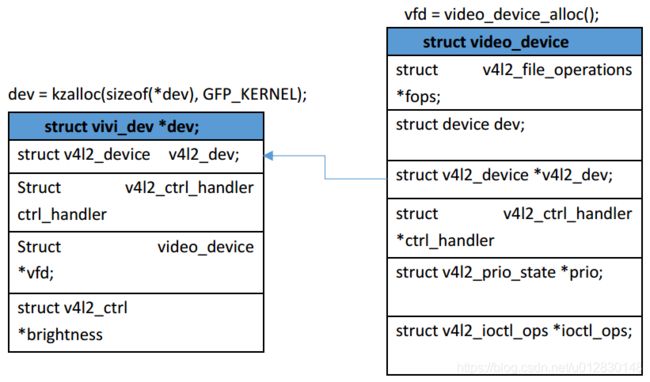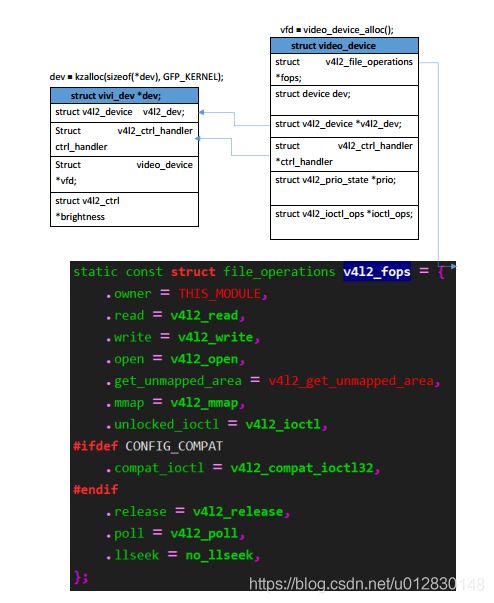linux V4L2框架分析
对于Linux内核里面的众多子系统,都采用了分层的思想来实现,V4L2子系统也不例外,跟framebuffer子系统类似似。V4L2子系统也分为两层。暂且分为核心层和硬件相关层。V4L2也是字符设备驱动程序,因此也脱离不了一般驱动程序的范围。
核心层:主要实现了字符设备驱动程序框架,使得驱动开发者不在关注字符设备驱动程序本身,只用关注硬件相关层即可,同事核心层也为上层APP提供了统一的访问接口,使得无论硬件如何变化,上层接口都能保持稳定。
硬件相关层:
以vivi.c为例分析V4L2框架:
module_init(vivi_init);
ret = vivi_create_instance(i);
dev = kzalloc(sizeof(*dev), GFP_KERNEL); //首先分配一个vivi_dev,
ret = v4l2_device_register(NULL, &dev->v4l2_dev);//并不重要,只是初始化一些
自旋锁引用计数等
v4l2_ctrl_handler_init(hdl, 11); //初始化一些属性,这些属性在ioctl的时候会被用到
dev->volume = v4l2_ctrl_new_std(hdl, &vivi_ctrl_ops,
V4L2_CID_AUDIO_VOLUME, 0, 255, 1, 200);
dev->brightness = v4l2_ctrl_new_std(hdl, &vivi_ctrl_ops,
V4L2_CID_BRIGHTNESS, 0, 255, 1, 127);
dev->contrast = v4l2_ctrl_new_std(hdl, &vivi_ctrl_ops,
V4L2_CID_CONTRAST, 0, 255, 1, 16);
dev->saturation = v4l2_ctrl_new_std(hdl, &vivi_ctrl_ops,
V4L2_CID_SATURATION, 0, 255, 1, 127);
dev->hue = v4l2_ctrl_new_std(hdl, &vivi_ctrl_ops,
V4L2_CID_HUE, -128, 127, 1, 0);
dev->button = v4l2_ctrl_new_custom(hdl, &vivi_ctrl_button, NULL);
dev->int32 = v4l2_ctrl_new_custom(hdl, &vivi_ctrl_int32, NULL);
dev->int64 = v4l2_ctrl_new_custom(hdl, &vivi_ctrl_int64, NULL);
dev->boolean = v4l2_ctrl_new_custom(hdl, &vivi_ctrl_boolean, NULL);
dev->menu = v4l2_ctrl_new_custom(hdl, &vivi_ctrl_menu, NULL);
dev->string = v4l2_ctrl_new_custom(hdl, &vivi_ctrl_string, NULL);
dev->v4l2_dev.ctrl_handler = hdl;接着分配一个 struct video_device *vfd;,并设置它,最后注册video_device
vfd = video_device_alloc();
*vfd = vivi_template;
vfd->debug = debug;
vfd->v4l2_dev = &dev->v4l2_dev;
set_bit(V4L2_FL_USE_FH_PRIO, &vfd->flags);
vfd->lock = &dev->mutex;
ret = video_register_device(vfd, VFL_TYPE_GRABBER, video_nr);vfd->v4l2_dev = &dev->v4l2_dev;
其实video_register_device可以看作是核心层的一个接口,他为硬件相关层提供了统一的注册接口,将video_device注册进核心层。在上面设置了vfd指向vivi_template, vivi_fops中提供了很多的操作函数,这些操作函数最终会被传进核心层,最终会被应用层调用到。
static const struct v4l2_ioctl_ops vivi_ioctl_ops = {
.vidioc_querycap = vidioc_querycap,
.vidioc_enum_fmt_vid_cap = vidioc_enum_fmt_vid_cap,
.vidioc_g_fmt_vid_cap = vidioc_g_fmt_vid_cap,
.vidioc_try_fmt_vid_cap = vidioc_try_fmt_vid_cap,
.vidioc_s_fmt_vid_cap = vidioc_s_fmt_vid_cap,
.vidioc_reqbufs = vidioc_reqbufs,
.vidioc_querybuf = vidioc_querybuf,
.vidioc_qbuf = vidioc_qbuf,
.vidioc_dqbuf = vidioc_dqbuf,
.vidioc_s_std = vidioc_s_std,
.vidioc_enum_input = vidioc_enum_input,
.vidioc_g_input = vidioc_g_input,
.vidioc_s_input = vidioc_s_input,
.vidioc_streamon = vidioc_streamon,
.vidioc_streamoff = vidioc_streamoff,
};
static struct video_device vivi_template = {
.name = "vivi",
.fops = &vivi_fops,
.ioctl_ops = &vivi_ioctl_ops,
.release = video_device_release,
.tvnorms = V4L2_STD_525_60,
.current_norm = V4L2_STD_NTSC_M,
};接着我们分析一下video_register_device(vfd, VFL_TYPE_GRABBER, video_nr);
static inline int __must_check video_register_device(struct video_device *vdev,
int type, int nr)
{
return __video_register_device(vdev, type, nr, 1, vdev->fops->owner);
}
int __video_register_device(struct video_device *vdev, int type, int nr,
int warn_if_nr_in_use, struct module *owner)
{
int i = 0;
int ret;
int minor_offset = 0;
int minor_cnt = VIDEO_NUM_DEVICES;
const char *name_base;
vdev->minor = -1;
/* v4l2_fh support */
spin_lock_init(&vdev->fh_lock);
INIT_LIST_HEAD(&vdev->fh_list);
/* Part 1: check device type */
switch (type) {
case VFL_TYPE_GRABBER:
name_base = "video"; //传入type参数为VFL_TYPE_GRABBER
break;
}
vdev->vfl_type = type;
vdev->cdev = NULL;
if (vdev->v4l2_dev) {
if (vdev->v4l2_dev->dev)
vdev->parent = vdev->v4l2_dev->dev;
if (vdev->ctrl_handler == NULL)
vdev->ctrl_handler = vdev->v4l2_dev->ctrl_handler;
if (vdev->prio == NULL)
vdev->prio = &vdev->v4l2_dev->prio;
}
switch (type) {
case VFL_TYPE_GRABBER:
minor_offset = 0;
minor_cnt = 64;
break;
for (i = 0; i < VIDEO_NUM_DEVICES; i++)
if (video_device[i] == NULL) //找出一个次设备号空项
break;
vdev->minor = i + minor_offset; //指定次设备号
vdev->num = nr;
devnode_set(vdev);
/* Part 3: Initialize the character device */
vdev->cdev = cdev_alloc(); //分配一个cdev ,这是字符设备驱动程序范畴
vdev->cdev->ops = &v4l2_fops; //设置ops
vdev->cdev->owner = owner;
ret = cdev_add(vdev->cdev, MKDEV(VIDEO_MAJOR, vdev->minor), 1); //添加进内核
/* Part 4: register the device with sysfs */
vdev->dev.class = &video_class;
vdev->dev.devt = MKDEV(VIDEO_MAJOR, vdev->minor);
if (vdev->parent)
vdev->dev.parent = vdev->parent;
dev_set_name(&vdev->dev, "%s%d", name_base, vdev->num);
ret = device_register(&vdev->dev); //注册设备
/* Register the release callback that will be called when the last
reference to the device goes away. */
vdev->dev.release = v4l2_device_release; //设置release函数
/* Increase v4l2_device refcount */
if (vdev->v4l2_dev)
v4l2_device_get(vdev->v4l2_dev);
#if defined(CONFIG_MEDIA_CONTROLLER)
/* Part 5: Register the entity. */
if (vdev->v4l2_dev && vdev->v4l2_dev->mdev &&
vdev->vfl_type != VFL_TYPE_SUBDEV) {
vdev->entity.type = MEDIA_ENT_T_DEVNODE_V4L;
vdev->entity.name = vdev->name;
vdev->entity.v4l.major = VIDEO_MAJOR;
vdev->entity.v4l.minor = vdev->minor;
ret = media_device_register_entity(vdev->v4l2_dev->mdev,
&vdev->entity);
}
video_device[vdev->minor] = vdev; //将vfd放入全局的video_device链表中
上面主要是核心层注册了一个字符设备。此时结构体间关系变为。
其中v4l2_fops即为核心层提供给应用层的统一接口,应用层通过调用统一的接口,最终能访问到硬件相关层。
接下来分析vivi.c的open,read,write,ioctl过程
1. open
app: open("/dev/video0",....)
---------------------------------------------------
drv: v4l2_fops.v4l2_open
vdev = video_devdata(filp); // 根据次设备号从数组中得到video_device
ret = vdev->fops->open(filp); //即上文中vivi_template.fops.open 即v4l2_fh_open
vivi_ioctl_ops.open
v4l2_fh_open
在上面中比较关键的一步是通过次设备号从 video_device数组中得到video_device。
struct video_device *video_devdata(struct file *file)
{
return video_device[iminor(file->f_path.dentry->d_inode)];
}
2. read
app: read ....
---------------------------------------------------
drv: v4l2_fops.v4l2_read
struct video_device *vdev = video_devdata(filp);
ret = vdev->fops->read(filp, buf, sz, off);
3. ioctl
app: ioctl
----------------------------------------------------
drv: v4l2_fops.unlocked_ioctl
v4l2_ioctl
struct video_device *vdev = video_devdata(filp);
ret = vdev->fops->unlocked_ioctl(filp, cmd, arg);
video_ioctl2
video_usercopy(file, cmd, arg, __video_do_ioctl);
__video_do_ioctl
struct video_device *vfd = video_devdata(file);
根据APP传入的cmd来获得、设置"某些属性"
v4l2_ctrl_handler的使用过程:
__video_do_ioctl
struct video_device *vfd = video_devdata(file);
const struct v4l2_ioctl_ops *ops = vfd->ioctl_ops;
case VIDIOC_QUERYCTRL:
{
struct v4l2_capability *cap = (struct v4l2_capability *)arg;
ret = ops->vidioc_querycap(file, fh, cap); //即调用vivi_template.ioctl_ops.vidioc_querycap函数。
static int vidioc_querycap(struct file *file, void *priv,
struct v4l2_capability *cap)
{
struct vivi_dev *dev = video_drvdata(file);
strcpy(cap->driver, "vivi");
strcpy(cap->card, "vivi");
strlcpy(cap->bus_info, dev->v4l2_dev.name, sizeof(cap->bus_info));
cap->version = VIVI_VERSION;
cap->capabilities = V4L2_CAP_VIDEO_CAPTURE | V4L2_CAP_STREAMING | \
V4L2_CAP_READWRITE;
return 0;
}其他调用过程类似。
由此我们可以看出,核心层应经为我们做了很多事情,我们不必再去关心字符设备驱动程序,只用关系和硬件相关的东西,按照V4L2的框架写出硬件相关层即可。

